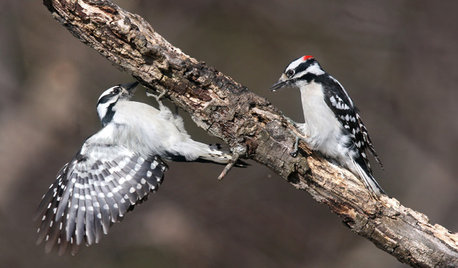Help Identify Dracaena(?)
LunaraWolf
10 years ago
Related Stories

GARDENING FOR BIRDSBackyard Birds: How to Identify Two Common Woodpeckers
Downy and hairy woodpeckers have similar coloration and behavior. But there are two big differences that separate them
Full Story
DECORATING GUIDESCould a Mission Statement Help Your House?
Identify your home’s purpose and style to make everything from choosing paint colors to buying a new home easier
Full Story
ORGANIZINGHelp for Whittling Down the Photo Pile
Consider these 6 points your personal pare-down assistant, making organizing your photo collection easier
Full Story
LIFEDecluttering — How to Get the Help You Need
Don't worry if you can't shed stuff and organize alone; help is at your disposal
Full Story
ORGANIZING4 Questions to Help You Organize Your Favorite Photos
Organize your keeper photos with a system that's just right for you, whether it's in the cloud or you can hold it in your hand
Full Story
ORGANIZINGGet the Organizing Help You Need (Finally!)
Imagine having your closet whipped into shape by someone else. That’s the power of working with a pro
Full Story
SELLING YOUR HOUSEHelp for Selling Your Home Faster — and Maybe for More
Prep your home properly before you put it on the market. Learn what tasks are worth the money and the best pros for the jobs
Full Story
MOVINGRelocating Help: 8 Tips for a Happier Long-Distance Move
Trash bags, houseplants and a good cry all have their role when it comes to this major life change
Full Story
SELLING YOUR HOUSE5 Savvy Fixes to Help Your Home Sell
Get the maximum return on your spruce-up dollars by putting your money in the areas buyers care most about
Full Story
DECLUTTERINGDownsizing Help: How to Edit Your Belongings
Learn what to take and what to toss if you're moving to a smaller home
Full Story










plantomaniac08
Tiffany, purpleinopp Z8b Opp, AL
Related Professionals
La Marque Landscape Architects & Landscape Designers · Montgomeryville Landscape Architects & Landscape Designers · Alamo Landscape Contractors · Brooklyn Park Landscape Contractors · Canby Landscape Contractors · Concord Landscape Contractors · Corona Landscape Contractors · Fort Atkinson Landscape Contractors · Hoffman Estates Landscape Contractors · Kailua Landscape Contractors · Lantana Landscape Contractors · Mission Bend Landscape Contractors · Wentzville Landscape Contractors · Garden City Interior Designers & Decorators · Van Wert Interior Designers & DecoratorsLunaraWolfOriginal Author
Tiffany, purpleinopp Z8b Opp, AL
LunaraWolfOriginal Author
LunaraWolfOriginal Author
Tiffany, purpleinopp Z8b Opp, AL
LunaraWolfOriginal Author
Tiffany, purpleinopp Z8b Opp, AL
LunaraWolfOriginal Author